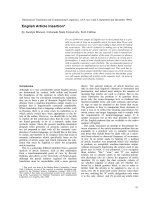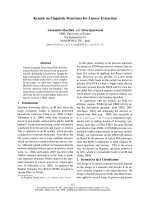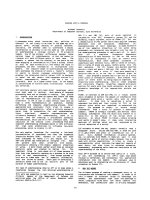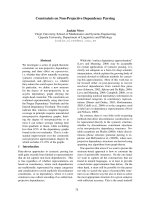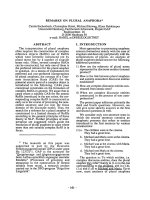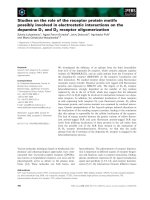Báo cáo khoa học: "Report on Research" docx
Bạn đang xem bản rút gọn của tài liệu. Xem và tải ngay bản đầy đủ của tài liệu tại đây (105.42 KB, 2 trang )
[
Mechanical Translation
, vol.3, no.2, November 1956; pp. 36-37]
Report on Research
Cambridge Language Research Unit, Cambridge, England
THE CAMBRIDGE Language Research Unit is
primarily concerned with analytic investigation
of language, and in particular with a correla-
tive study of the descriptive-linguistic, logical,
algebraic and other notational characteristics
of natural languages and of translation between
natural languages. Much of this work is rele-
vant to machine translation and the following
four sections by members of the unit illustrate
some of the applications that are being made.
The first three are concerned with the possibi-
lities of using a mechanical thesaurus; the
fourth deals with mechanical translation via an
interlingua.
Potentialities of a Mechanical Thesaurus
(M. Masterman)
The unit of a mechanical dictionary is the
semantically significant "chunk", not the free
word. From a logical point of view, uncoded
MT dictionary entries form "trees", the paths
of which can be determined, to a significant
extent, by objective criteria. However, these,
as they stand, are too complicated to be used
directly for MT.
Attempts to construct multilingual MT dic-
tionary entries show that the entries form, not
trees, but algebraic lattices, with translation
points at the meets of the sublattices. It also
emerges that the complexity of the entries need
not increase greatly with the number of lan-
guages, since translation points can, and do,
fall on one another.
Such a multilingual MT dictionary is analogous,
in various respects, to a thesaurus. A method
of using such a thesaurus to refine the mecha-
nical pidgin output of a bilingual mechanical
dictionary has been devised.
Mechanical Translation Program Utilizing an
Interlingual Thesaurus
(A.F. Parker-Rhodes)
The problem of setting the information con-
tained in a fully general interlingual thesaurus
into coded form for the use of an electronic
computer would be formidable if not impossible
of practicable solution, if it were necessary to
include every entry as such. But if we could
devise a system of coding such that each entry
is represented by a numeral which would be
calculated from information to hand respecting
the current context-situation and the code-
number given for the input word under consider-
ation, then we could dispense with any actual
thesaurus entries in the computer's storage,
all the relevant information being contained in
the input and output dictionaries which respec-
tively provide the code-number of the input
words and decode the numbers, calculated from
these and the context, into the target language.
Mathematically, the problem is completely
soluble, provided no limit is placed on the length
of numerical symbols. If we limit ourselves to
a practicable length of symbol, the question of
adapting the general mathematical solution to
actual use becomes one of ingenuity which can
probably be solved, but which can only be as-
sessed by practical effort. The mathematical
procedure consists in finding a set of Boolean
operations having certain prescribed properties
which can be deduced from the conditions of the
problem. These operations are few in number
and could be built into a computer; being
Boolean, they can be performed with very great
speed.
A model solution, substantially simpler than
that recommended for actual trial, will be de-
scribed, and an example worked in it will be
demonstrated. This will show up the sort of
crossword-puzzle ingenuity required to devise
a suitable context classification. The attrac-
tion of the method, despite this inevitable lack
of elegance, is that it makes the computer
actually calculate instead of merely looking
things up in lists, and thus makes the whole pro-
cedure capable of sufficient speed to be feasible
for a mechanical-translation program.
Linguistic Basis of the Thesaurus-Type Mecha-
nical Dictionary and its Application to English-
Preposition Classification.
(M.A.K. Halliday)
The thesaurus method of mechanical lexico-
graphy is an attempt to systematize the lexis
in such a way that the "one-to-one word equi-
valence" principle can be maintained as the
first stage in the dictionary, since the mechani-
cal application of the concept of "primary
Report on Research 37
meaning" implicit in this principle requires the
arrangement of secondary translation equiva-
lents into contextually determined systems.
Each entry, consisting of a "key word" and its
associates, constitutes one such system.
Multiple translation equivalence requires the
specification of the conditions under which one
of the terms in the closed system of a thesaurus
entry is to be selected, these conditions being
contextual features of the target language. This
is illustrated by a "context-continuum" showing
some word equivalence in non-technical rail-
way terminology in four languages.
The thesaurus exploits the redundancy of the
target language by handling its word classes
without comparative identification. The
autonomous treatment of the target language
reduces the loss of determination involved in
the translation process.
Among the word classes established for En-
glish as a target language, prepositions are
particularly suited by their relatively low en-
tropy to non-comparative treatment. Preposi-
tions are classified as "determined" and
"commutative". The former are listed as sub-
entries of the determining word, having a single
or multiple sub-entry according as they are
wholly or partially determined. The latter con-
stitute separate headings and are placed in
closed commutation systems which differ from
those set up for e.g. nouns in that they are in
the first instance grammatically, not contextu-
ally, restricted.
General Program for Mechanical Translation
between Any Two Languages via an Algebraic
Interlingua. (R.H. Richens)
It has become clear that the amount of
lexical and syntactical analysis required to
produce a smooth and idiomatic mechanical
translation from any base language into any
target language is very great. It is interesting,
therefore, to examine the possibilities of me-
chanical translation via a notational interlingua.
With this approach, only one program is en-
visaged for translation between any two lan-
guages, with the addition of specific mechanical
dictionaries for each input and output language.
The notational interlingua being studied is
ideographic and constructed so as to represent
the ideas of any base passage divested of all
lexical and syntactical peculiarities; for which
reason it is called Nude. The words in Nude
are constructed of some fifty elements (Roman
letters, capitals and lower case letters being
regarded as different symbols), each of which
denotes some basic idea such as plurality.
animal, or negation. A word in Nude may con-
sist of one letter only; the more complex a
notion, the more letters are required. Each
word in Nude is regarded as a relation, either
0-ad, 1-ad, or 2-ad; 1-ads are preceded by a
point, 2-ads by a colon. Punctuation in Nude
is used to indicate the concatenation of the
words. The words linked by a 2-ad relation
precede it and are separated by a comma, e.g.,
A, B:C; coordinate conjunction is expressed by
a hyphen, e.g., A-B.C.
The translation program involves the follow-
ing operations:
(1)
Matching semantically significant "chunks"
of the base passage against the Base-Nude
dictionary.
(2)
Reorganization of the syntax into Nude
syntax by the method of cyclical reduction
described at the 1955 Symposium of the
Cambridge Language Research Unit, utili-
zing the word-class sequence entries of
the Base-Nude dictionary (cf. MT III, 1).
(3)
Treatment of chunk-chunk, chunk conju-
gation and chunk-semantic interactions
by comparison with the appropriate inter-
action entries in the Base-Nude dictionary.
(4)
Repetition of the above stages, using the
Nude-Target mechanical dictionary. The
potentialities of this method are to be
illustrated by translation from a Japanese
passage into English, German, Latin and
Welsh.
List of Publications of the C.L.R.U.
1.
Progress Report I (January, 1953), obtain-
able cyclostyled from C. L. R. U., 20 Milling-
ton Road, Cambridge, England.
2.
Progress Report II, MT Vol. 3, No.l.
3.
Annexe V to same is obtainable cyclostyled
from Editors (MT).
4.
The Potentialities of a Mechanical Thesaurus
by Margaret Masterman.
5.
A General Program for Mechanical Trans-
lation between any Two Languages via an
Algebraic Interlingua, by R.H. Richens.
6.
The Linguistic Basis of the Thesaurus-Type
Mechanical Dictionary and its Application to
English Preposition Classification, by M. A.
K. Halliday.
7.
An Algebraic Thesaurus, by A.F. Parker-
Rhodes .

